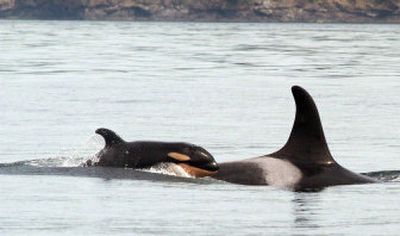Puget Sound orcas endangered

SEATTLE – The federal government on Tuesday listed Puget Sound orcas as an endangered species, giving them the highest level of protection available under the law and a designation that will help target pollution and other factors that have contributed to the whales’ decline.
The announcement pleasantly surprised environmentalists because it came nearly a year after the National Marine Fisheries Service proposed listing the killer whales as threatened, but not endangered. “Threatened” reflects a species at risk of becoming endangered; “endangered” reflects a species at risk of becoming extinct.
“Between the time we proposed to list these animals as threatened and now, we’ve discovered the population is in a more delicate situation than we had assumed,” said Brian Gorman, a fisheries service spokesman.
The three pods of orcas that live in Puget Sound from late spring to early fall number 89 whales – down from historical levels of more than 100 in the middle of the last century, but up from a low of 79 in 2002. Their numbers have gone through three periods of decline since the late 1960s and early ‘70s, when dozens were captured for aquariums – with each decline followed by a slight rebound.
The killer whales had been covered by the Marine Mammal Protection Act, which kept them from being killed or harassed. The new listing under the Endangered Species Act will require federal agencies to make sure their activities do not harm the whales and will provide better protection against the factors contributing to their decline, including pollution and a loss of prey, namely salmon.
The government will also have to come up with a recovery plan for the species.
Fred Felleman, a longtime advocate for the whales, said the listing is great news – “as long as Congress doesn’t gut the law.” Last month, the House of Representatives passed an overhaul of the Endangered Species Act that would reduce the government’s role in protecting plants and animals, but passage in the Senate is uncertain.
“This is a reflection that any singular event – an oil spill, a disease outbreak, some toxic algae – could send the whales into extinction,” Felleman said. “Any singular event could be catastrophic to the population.”
Eight environmental groups sued in December 2002 over the government’s refusal to list the whales under the Endangered Species Act. The government had argued that it couldn’t list them because the Puget Sound orcas – known collectively as the Southern resident orcas, or J, K and L pods – were not biologically distinct from other orcas.
The environmental groups argued that Puget Sound orcas have a different diet and different features from other orcas, don’t mate with other orcas, use different sounds to communicate, and are distinct in showing such an attachment to one geographic region. A federal judge ordered the fisheries service to reconsider.
In response, the agency suggested listing the orcas as threatened, a listing that would afford the whales all the protections of the Endangered Species Act. Upon further review, and at the request of environmentalists, the fisheries service decided the “endangered” listing was more appropriate.
There is little difference in protection provided under each listing; it’s mostly a reflection of the peril faced by the species.
“If I were a killer whale, I wouldn’t notice any difference,” Gorman said.
Felleman, who has studied Puget Sound’s orcas since graduate school in 1980, said the effects of the designation are likely to be wide-ranging. Possibilities include restrictions on whale-watching boats and underwater sonar tests performed by the Navy, both of which are believed to increase stress on the whales.
The government will have to consider the effects of its activity on orcas, he added – for example, if the Coast were to add or expand boating lanes in Puget Sound and the Strait of Juan de Fuca, or if the Army Corps of Engineers were to permit the building of a new dock. And the government may be prompted to study where the whales go in the winter – a mystery no one has solved.
Patti Goldman, a managing attorney with Earthjustice environmental law firm in Seattle, said the “endangered” listing might help environmental groups win more money from the federal government to protect the orcas.
“This will give us the will and the tools to take the actions that will allow them to survive,” Goldman said. “It’s been a long time coming. It’s time now to roll up our sleeves and make this listing work for the orcas.”
Kathy Fletcher, executive director for the environmental group People for Puget Sound, said the listing will bolster legal arguments for expediting the cleanup of contamination in the sound. Conservation groups plan to lobby for a ban on flame retardant chemicals found in everything from electronics to plastics to furniture – chemicals that have been found in the whales.
The presence of such chemicals increases up the food chain. They collect in the blubber of killer whales. When the whales can’t find enough salmon, or when females nurse their calves, they begin to metabolize their blubber, and the chemicals can cause reproductive, immune system or other health problems, Fletcher said.
One whale from J pod, an apparently healthy young male who biologists believed had fathered several calves, died in the prime of his life in 1999, Felleman said. A necropsy revealed he had never produced any sperm and that his body was riddled with disease. Scientists blamed the pollutants.